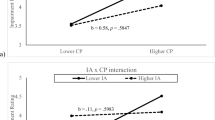Abstract
The Adelaide-Conners Parent Rating Scale (APRS), an instrument developed by studying a large, representative group of schoolchildren, was used with a group of psychiatry attenders. Multimethod factor analysis found satisfactory agreement between the factor structures of the clinical and the normative groups. The patterns of scores on the 12 APRS scales were also compared. Two higher-order factors (Conflict with the Environment and Conflict within the Self) were identified in the clinical sample as previously found in the normative group. Comparison of the factor solutions with previous empirical efforts to identify parent-perceived patterns of child behavior disorder showed that the APRS compares well with other instruments and supports the strategy of proceeding from the study of normative populations to the study of clinically defined groups.
Similar content being viewed by others
References
Achenbach, T. M. (1966). The classification of children's psychiatric syndromes: A factor-analytic study.Psychological Monographs,80(7), Whole No. 615.
Achenbach, T. M. (1978). The Child Behavior Profile I. Boys aged 6–11.Journal of Consulting and Clinical Psychology, 46, 478–488.
Achenbach, T. M., & Edelbrock, C. S. (1978). The classification of child psychopathology: A review and analysis of empirical efforts.Psychological Bulletin, 85, 1275–1301.
Achenbach, T. M., & Edelbrock, C. S. (1979). The Child Behavior Profile II. Boys aged 12–16 and girls aged 6–11 and 12–16.Journal of Consulting and Clinical Psychology, 47, 223–233.
Achenbach, T. M., & Edelbrock, C. S. (1983).Manual for the Child Behavior Checklist and Revised Child Behavior Profile. Burlington, VT: University Associates in Psychiatry.
Barlow, J. A., & Burt, C. (1954). The identification of factors from different experiments.British Journal of Mathematical & Statistical Psychology, 7, 52–56.
Cattell, R. B. (1952).Factor analysis: An introduction and manual for the psychologist and social scientist. New York: Harper & Brothers.
Conners, C. K. (1969). A teacher rating scale for use with drug studies with children.American Journal of Psychiatry, 126, 152–156.
Conners, C. K. (1970). Symptom patterns in hyperkinetic, neurotic and normal children.Child Development, 41, 667–682.
Conners, C. K. (1973). Rating scales for use in drug studies with children.Psychopharmacology Bulletin;Special Issue 1973, Pharmacotherapy with Children, 24–84.
Glow, R. A. (1981). Cross-validity and normative data on the Conners' Parent and Teacher Rating Scales. In K. D. Gadow & J. Loney (Eds.),Psychosocial aspects of drug treatment for hyperactivity, AAAS Selected Symposia Series (pp. 107–150). Boulder, CO: Westview Press.
Glow, R. A., & Glow, P. H. (1980). Peer and self-rating: Children's perception of behavior relevant to hyperkinetic impulse disorder.Journal of Abnormal Child Psychology, 8, 471–490.
Glow, R. A., & Glow, P. H. (1984). From trait to category of child behavior disorder. In R. A. Glow (Ed.),Advances in the behavioral measurement of children (Vol. 1). Greenwich, CT: JAI Press.
Glow, R. A., Glow, P. H., & Rump, E. E. (1982). The stability of child behavior disorders: A one year test-retest study of Adelaide versions of the Conners Teacher and Parent Rating Scales.Journal of Abnormal Child Psychology, 10, 33–60.
Harman, H. H. (1968).Modern factor analysis. Chicago: University of Chicago Press.
Jackson, D. N. (1969). Multimethod factor analysis in the evaluation of convergent and discriminant validity.Psychological Bulletin, 72, 30–49.
Kaiser, H. F., Hunka, S., & Bianchini, J. (1969). Relating factors between studies based upon different individuals. In H. J. Eysenck & S. B. G. Eysenck (Eds.),Personality structure and measurement. London: Routledge & Keegan Paul.
Lahey, B. P., Green, K. D., & Forehand, R. (1980). On the independence of ratings of hyperactivity, conduct problems, and attention deficits in children: A multiple regression analysis.Journal of Consulting and Clinical Psychology, 48, 566–574.
Nie, N. H., Hull, C. H., Jenkins, J. G., Steinbrunner, K., & Bent, D. H. (1975).Statistical package for the social sciences (2nd ed.). New York: McGraw-Hill.
Pinneau, S. R., & Newhouse, A. (1964). Measures of invariance and comparability in factor analysis for fixed variables.Psychometrika, 29, 271–281.
Ross, A. O. (1974).Psychological disorders of children: A behavioral approach to theory, research and therapy. New York: McGraw-Hill.
Sandberg, S. T., Wieselberg, M., & Shaffer, D. (1980). Hyperkinetic and conduct problem children in a primary school population: Some epidemiological considerations.Journal of Child Psychology and Psychiatry, 21, 243–311.
Stein, M. A., & O'Donnell, J. P. (1985). Classification of children's behavior problems: Clinical and quantitative approaches.Journal of Abnormal Child Psychology, 13, 269–280.
Author information
Authors and Affiliations
Additional information
This work was supported in part by a grant from the Department of Health, Canberra.
Rights and permissions
About this article
Cite this article
Glow, R.A., Glow, P.H. & White, M. Parent-perceived child behavior problems: Comparison of normative and clinical factors of the Adelaide-Conners Parent Rating Scale. J Psychopathol Behav Assess 9, 255–280 (1987). https://doi.org/10.1007/BF00964556
Accepted:
Issue Date:
DOI: https://doi.org/10.1007/BF00964556



